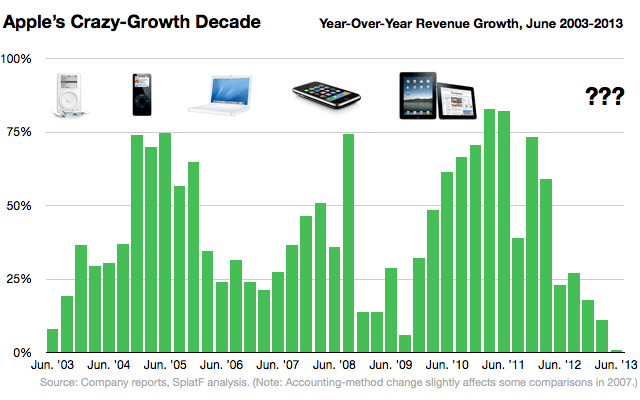
Apple's stunning growth over the past decade has been one of the biggest stories in all of tech. Even as the company released new product after new product, and grew larger and larger, its growth rate continued to accelerate, far surpassing its competitors.
For the past ten years, Apple has posted year-over-year revenue growth every quarter, almost always more than 25% and frequently more than 50%. In that span, it's gone from a company with less than $2 billion in quarterly sales to one with (once) more than $50 billion. For two quarters in a row in 2011, as the iPad and iPhone both picked up steam, Apple posted growth rates above 80% — each quarter representing more than $10 billion in new sales from the year prior. That's just crazy for a company that big.
But now, that unbelievable growth rocket has come back to earth. Apple's most recent quarter, reported today, showed just 1% growth over last year. And it's not a fluke: Growth has sloped down for more than a year. After a great winter in 2011-2012, when Apple's sales grew 73%, then 59%, it's been 23%, 27%, 18%, 11%, and now 1%. For its next quarter, Apple expects growth ranging from 3% to a 5% year-over-year decline.
What happened? Some of it's just funny timing: A product launch early one year then late the next. Inventory adjustments as products mature and markets settle — this played a role in this past quarter's weakish iPad sales, for example. This year, in particular, Apple has been quiet on the new-gadget front, as design boss Jony Ive rehauls its iOS operating system, presumably for new iPhones, iPods, and iPads in time for Christmas. This is where arbitrary quarterly marking periods can sometimes cloud the lens.
But there's also been a bigger-picture trend that Apple can't just replicate: The vast shift towards smartphones and tablets — the "post-PC" revolution. Apple has captured this movement brilliantly, dominating the industry's sales and profits despite selling relatively fewer, mostly high-end devices. And it may continue to do so. But that first-time adoption cycle isn't going to happen again. At least not in the markets where Apple is strongest — and where carrier subsidies allow for such high profit margins — like the United States.
So what can Apple do next, assuming it wants to continue to grow? (A safe assumption.)
One obvious answer is to move downmarket in its existing product lines. This is always a tricky proposition with Apple, because the company swears it would never release a low-quality product that it isn't proud of. (And it shouldn't.) So far, this has meant selling old iPhones at reduced prices, which has been pretty successful. But if the growth is happening in even further-downmarket segments, Apple might have to even figure out something cheaper. Where will it draw the line, design- and quality-wise, to compete? We may find out this year if rumored low-cost iPhones are real.
Another possibility, of course, is to blaze into new markets. There's been speculation for years that Apple will start to sell television sets. The latest chatter is about wearable computers — Apple gadgets for the wrist, à la Nike's Fuelband.
The nice thing about wearables is that like smartphones — and unlike, say, desktop PCs — they're the kind of device where everyone in the house will need their own, meaning a larger potential market, people-wise. But unlike mobile phones, there isn't an established precedent for subsidies, carrier distribution, or even pricing, really. Can Apple design the kind of thing you'd want to wear on your body all day? We'll see. Will that create the same level of demand, favorable pricing, and high margins that the rise of smartphones did? Probably not. Still, if it's a hit, it could certainly fuel significant growth for Apple.
So that's the big question going forward: Can anything propel Apple's growth the way the iPhone and iPad did over the past 6 years, and the iPod and Mac before them?
Longtime Apple analyst Gene Munster asked a version of that question on today's earnings call: "Are there product categories out there that are big enough to move the needle for Apple?" Apple CEO Tim Cook's response: "We'll see, Gene. We're working up some stuff that we're really proud of, and we'll see how it does." And, in typical Apple fashion, "We'll announce things when we're ready."
Dan Frommer is founder of SplatF, a tech news site, and City Notes, a mobile travel startup. He previously helped create Business Insider, where he led Apple coverage. Follow Dan on Twitter at @FromeDome.
No hay comentarios:
Publicar un comentario